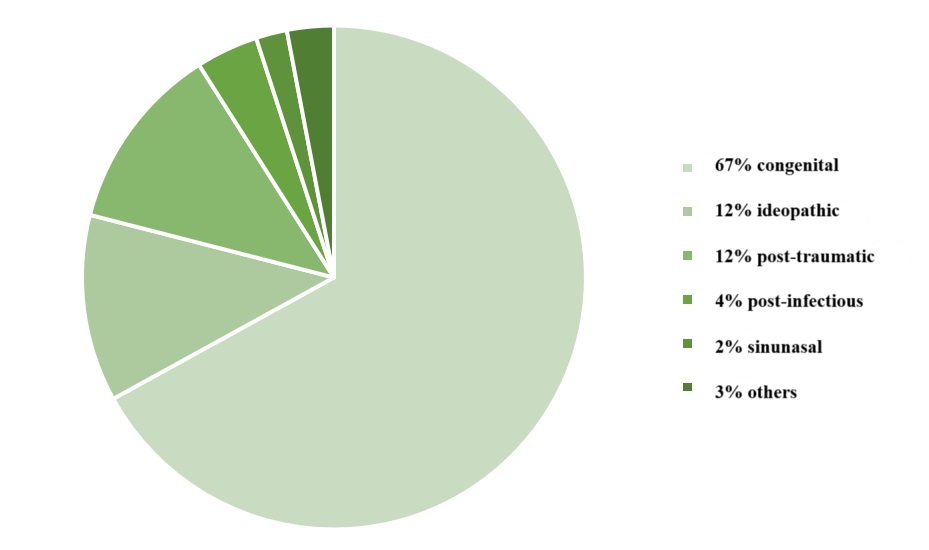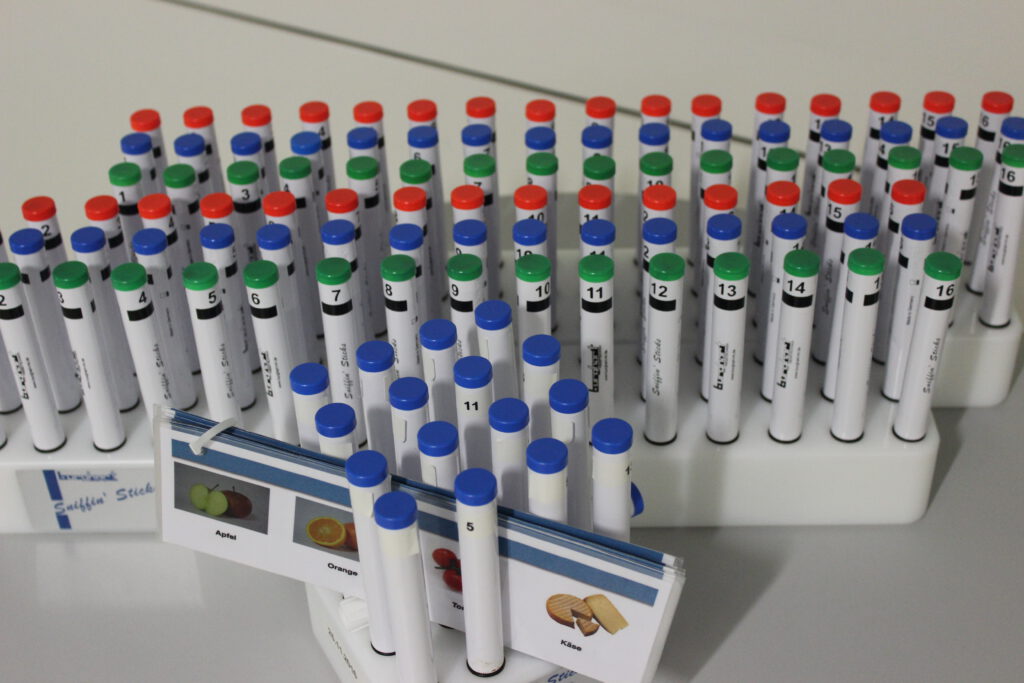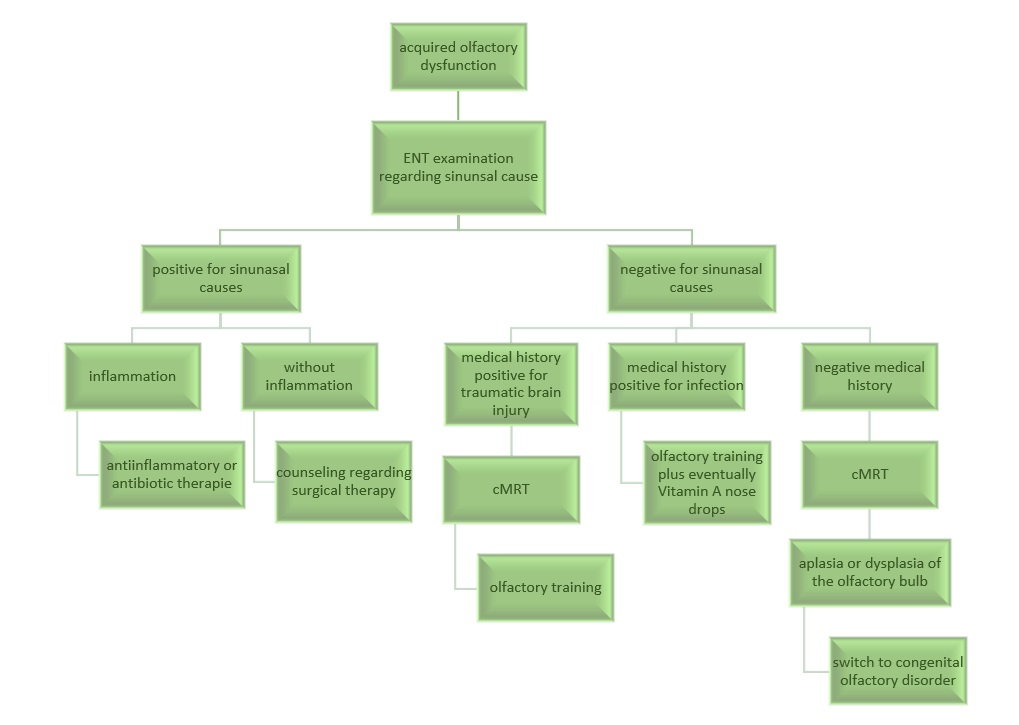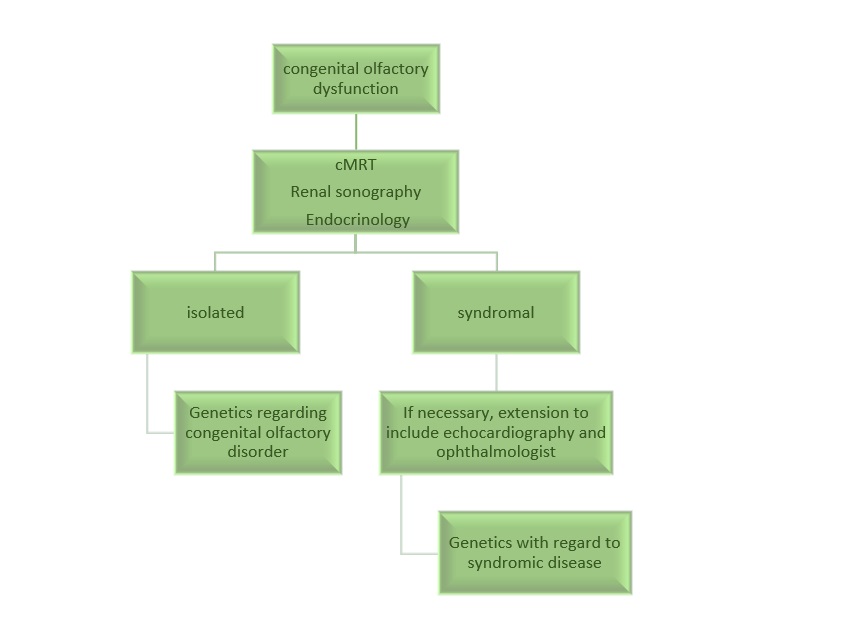Olfactory dysfunction can take different forms, ranging from a complete loss or absence of olfactory function (anosmia) to a quantitative reduction in olfactory function (hyposmia). There are also olfactory disorders associated with an abnormal perception of odors (parosmia). The effects of impaired olfactory function extend to various aspects of daily life. In particular, potential impairments in areas such as home safety (e.g. due to lack of perception of fire hazards or smoke), nutrition (e.g. due to consumption of spoiled food) and social interactions (due to lack of perception of one’s own body odor) need to be considered.
Causes and incidence of olfactory disorders in childhood and adolescence
There are two basic categories of olfactory disorders in childhood and adolescence: congenital and acquired. In congenital olfactory disorders, children are born without a sense of smell. These congenital olfactory disorders can occur in isolation or in association with certain syndromes, such as Kallmann syndrome or CHARGE syndrome. Interestingly, although congenital olfactory disorders are present from birth, on average they are not noticed until around 10 years of age. The diagnosis of ‚congenital anosmia‘ is often only made after many years, which can be a long and stressful time for those affected, involving numerous visits to the doctor.
Acquired olfactory disorders can occur in childhood and adolescence for a variety of reasons, including traumatic brain injury, enlarged tonsils (adenoid hypertrophy) or post-infectious complications.
The majority of children and adolescents who seek medical attention for olfactory disorders have congenital olfactory disorders, while acquired olfactory disorders are comparatively less common. The exact prevalence of olfactory disorders in children and adolescents remains unclear. However, compared to adults, olfactory disorders are much less common in this age group. A rough estimate is that about 1 in 8000 newborns is born without a distinct sense of smell.

Diagnostic of olfactory dysfunction
In order to determine the quantity, quality and possible prognosis of the olfactory disorder, it is necessary to carry out a structured clarification of the symptoms. The basic outpatient diagnosis consists of a detailed medical history and a psychophysical olfactory test, which should then be supplemented by specific further diagnostics depending on the suspected diagnosis.
At the initial presentation, a structured history should be taken, taking into account possible triggering events, accompanying symptoms, family history, relevant previous illnesses and operations in the ENT area, medications taken and any noxious substances. Patients should also be asked if they suffer from phantosmia (perceiving odors that are not there, e.g. an odorless room smells acridly of smoke without a source of odor) or parosmia (perceiving odors differently than they actually smell, e.g. coffee smells like dog food). A specific family history of intrafamilial clustering of olfactory dysfunction adds to the suspicion of congenital olfactory dysfunction.
It should be noted that subjective assessment of olfactory function alone is not sufficient. Standardised tests of olfactory function must therefore be carried out.

In German-speaking countries, psychophysical olfactory testing is then carried out using the Sniffin‘ Sticks Test. This is the most widely used here and is based on standardized data for children.

In children, the test consists of two parameters. The odor threshold, in which the individual perception threshold of an odor is determined, and odor identification, in which odors suitable for children are identified using picture cards, are tested.
Acquired olfactory dysfunction
To exclude sinonasal olfactory dysfunction as part of the diagnosis of acquired olfactory loss, it is advisable to refer the individual to an ENT specialist to evaluate for possible causes such as polyps or other obstructive changes in the olfactory cleft. If there is no sinonasal cause for the olfactory dysfunction, a history of post-infectious or post-traumatic olfactory dysfunction should be considered.
In order to rule out possible sequelae of trauma, a cranial MRI should be performed promptly in the case of traumatic brain injury with loss of smell. It is advisable to include the olfactory bulb in the MRI scan, especially with T2-weighted coronal slice thickness of 2 mm. Once sinonasal, post-infectious and post-traumatic causes have been ruled out, the condition is considered idiopathic. Anomalies of the anatomical structures in the MRI of the skull, such as an aplastic or dysplastic olfactory bulb, should lead to an extended diagnosis with regard to a possible congenital olfactory disorder.

Congenital olfactory disorders
The group of congenital olfactory disorders is divided into syndromic olfactory disorders and isolated congenital anosmia. In order to make a precise distinction, it is advisable to carry out an environmental diagnosis with regard to accompanying malformations and malfunctions that are often associated with olfactory disorders. These include renal anomalies and endocrinological disorders. Diagnostics in these patients should therefore include cranial MRI, renal ultrasound and endocrinological investigations. In the absence of other abnormalities, isolated congenital anosmia is strongly suspected. Variants in several genes (e.g. CNGA2, TENM1, KCNA3 and OBPIIa) have also been described in this form of the disease, so genetic testing of affected children should be considered.
